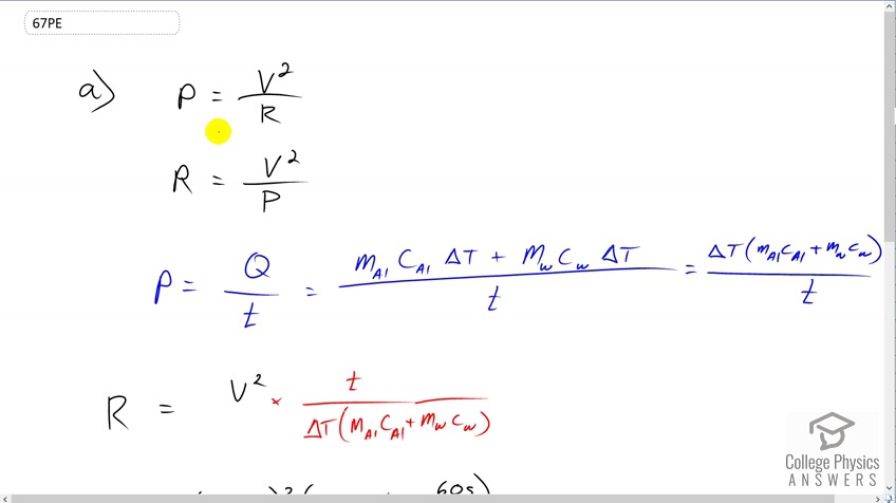Question
(a) An immersion heater utilizing 120 V can raise the temperature of a aluminum cup containing 350
g of water from to in 2.00 min. Find its resistance, assuming it is constant during the process. (b) A lower resistance would shorten the heating time. Discuss the practical limits to speeding the heating by lowering the resistance.
Final Answer
- A lower resistance would increase the current. There's a limit to how much current the power supply can provide before tripping a circuit breaker.
Solution video
OpenStax College Physics, Chapter 20, Problem 67 (Problems & Exercises)

vote with a rating of
votes with an average rating of
.
Calculator Screenshots
Video Transcript
This is College Physics Answers with Shaun Dychko. In this question we’re given some information about an immersion heater, which is a heater that goes into a vessel of fluid and a couple of Aluminum cup of water in this case. And we want to find out what is the resistance of this heater. Well, the power output of the heater is the voltage squared over resistance. And we can solve this for R by what should bring via R over P. The reason we’re doing this is because we’re given the voltage, 120 Volts. And we could figure out what the power output of the heater is based on the information we’re given about how quickly a given quantity of water in Aluminum heat up. So, here’s an expression for power. And it’s going to be the amount of heat energy absorbed divided by time. And time is two minutes and then, the heat absorbed depends on the masses and the specific heat of the materials here. So, we have mass of the Aluminum times the Aluminum specific heat multiplied by its change in temperature. This is from Chapter 14, if you need to review that, by the way. And then, add to that the mass of the water multiplied by the water specific heat times the change in temperature. And we factor out this delta T, change in temperature from the both this factors. And then we substitute this in for P. But we’re dividing by P. And so in this expression for resistance, we’re going to multiply by its reciprocal. So we have resistance is voltage squared multiplied by the reciprocal of the power. And that is time divided by change in temperature times mass of Aluminum times specific heat of Aluminum plus mass of water times specific heat of water. So, now we plug the whole bunch of numbers in. So, we have 120 Volts in squared times two minutes with all that takes to heat up the water times by 60 seconds per minute because we want our units to be in meters, kilograms and seconds usually, in MKS units. And we divide that by 95 degrees Celsius final temperature minus 20 degrees Celsius initial temperature times one times ten to the two grams of Aluminum, multiplied by one kilogram for every thousand grams, multiplied by the specific heat of the Aluminum which I looked up in table of Chapter 14, 900 Joules per kilograms Celsius degree. And then add to that 0.35 kilograms of water multiplied by the specific heat of water which is 4,186 Joules per kilograms Celsius degree. And so the resistance must be 14.8 ohms. And if the immersion heater at a lower resistance, it would heat up the heater faster but it would also increase the current that it draws. And an increased current in the wires supplying the immersion heater’s power could heat up. And so there’s a limit to how much current the power supply can provide.
